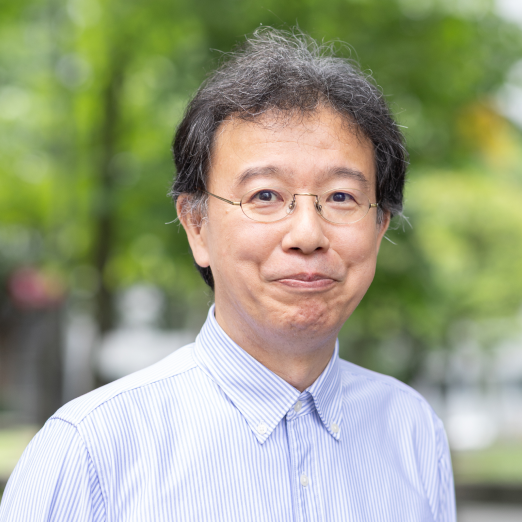
山崎 義弘 教授
Kenji YASUDA
専門分野
統計物理学・非線形動力学
「自然の造形」に対する 物理からのアプローチ
研究テーマ
パターン形成の物理/粘着の物理/対戦型スポーツへの統計物理からのアプローチ/超離散力学系
LINKS
RESEARCH OVERVIEW
研究概要
私たちの身の回りには、「自然の造形物」が満ちあふれています。たとえば、桜の木の枝ぶり、雪の結晶、夜空の星雲、ガラスのひび割れ、細菌のコロニーなど。さらに群れを成して鳥や魚が飛行したり泳いだりしている様も、群れの集団をひとつの形として捉えれば、やはり自然の造形として考えることができるでしょう。これら自然の造形物は一見すると複雑で、多様な印象を受けるかもしれません。私たちは、多様で複雑に見える自然の造形に対して、構成要素の詳細によらないで、「パターン」として捉えることで、個別の現象に共通の形成メカニズムを浮かび上がらせることを目標に研究を行っています。
実際、私たちは古くから「パターン」という再現性のある視覚的な情報による自然からのメッセージに感銘を受け、また利用してきました。具体的な例をひとつ挙げれば、フラクトグラフィという分野では材料が破壊したときに生じた破断面をパターンとして分析し、破壊した時に材料に働いた力を推測する事が行われ、 工業的にも利用されています。物理学の分野では非平衡散逸系、非線形動力学などで代表されるテーマとしてここ数十年来、活発に研究が行われ、特に化学反応系や熱対流で観られるパターンが指導的な役割を果たし、界面ダイナミクスや位相ダイナミクスといった縮約法が開発、整備されてきました。さらに最近は計算機、測定機器の向上に伴い、パターンの形成過程をリアルタイムに観察し記録し、シミュレーションと定量的に比較する事が簡単になってきました。
「パターン形成の物理」は自然を理解するための強力な枠組みであり、今後さらに発展していくであろうと確信しています。また、研究対象が物理系にとどまらず、化学系・生物系など広範に渡っている点や、現象の捉え方は必ずしも物理学の既存分野には収まらないかも知れません。私たちは、絶えず変化していく自然の造形に、物理学からアプローチして、地道な研究を重ねることによって学問分野として確立させていきたいと考えています。
学歴・経歴
2003年4月より、早稲田大学 理工学部 専任講師
その後、助教授・准教授を経て、
2010年4月より、早稲田大学 理工学術院 先進理工学部 教授
所属学協会
- 日本物理学会
- 日本応用数理学会
- 日本接着学会

Yamazaki, Yoshihiro
Professor
Field of study
Statisitical Physics, Nonlinear Dynamics
Physical Approaches to Patterns in Nature
Research Themes
of Pattern Formation / Statistical Physics Approaches to Competitive Sports / Ultradiscrete Dynamical Systems
RESEARCH OVERVIEW
Our surroundings are filled with natural forms. Examples include the branching patterns of cherry trees, the intricate structures of snowflakes, nebulae in the night sky, fracture lines in glass, and colonies of bacteria. Even the collective motion of flocking birds or schooling fish—when regarded as a single morphological entity—can be understood as a form created by nature.
At first glance, such natural forms may appear complex and diverse. However, our research aims to reveal the underlying mechanisms common to these seemingly disparate phenomena by interpreting them in terms of patterns, rather than focusing on the microscopic details of their individual components.
Indeed, humanity has long been inspired by, and has made use of, visual patterns in nature as reproducible messages. For instance, in the field of fractography, fracture surfaces created when materials break are analyzed as patterns to infer the forces involved at the moment of failure—an approach that has found practical application in industrial contexts.
In physics, the study of pattern formation has been vigorously pursued for several decades, particularly in the contexts of nonequilibrium dissipative systems and nonlinear dynamics. Patterns observed in chemical reaction systems and thermal convection have played leading roles in driving the field, prompting the development and refinement of reduction methods such as interface dynamics and phase dynamics.
Recent advances in computational power and measurement technology have further enabled us to observe and record the process of pattern formation in real time, and to compare such observations quantitatively with numerical simulations.
The physics of pattern formation offers a powerful framework for understanding nature and is expected to advance further in the future. Notably, the scope of research in this area is not confined to physical systems; it extends broadly to chemical and biological systems, and the phenomena under investigation often do not fit neatly into existing categories within physics.
Through a sustained, physics-based approach to the ever-changing forms of nature, we aim to establish this line of inquiry as a coherent academic discipline in its own right.
Education and Career
In April 2003, appointed as a full-time lecturer at the Faculty of Science and Engineering, Waseda University.
Subsequently served as an associate professor, and since April 2010, a professor at the School of Advanced Science and Engineering, Faculty of Science and Engineering, Waseda University.
Professional Memberships
- The Physical Society of Japan
- The Japan Society for Industrial and Applied Mathematics
- The Adhesion Society of Japan
